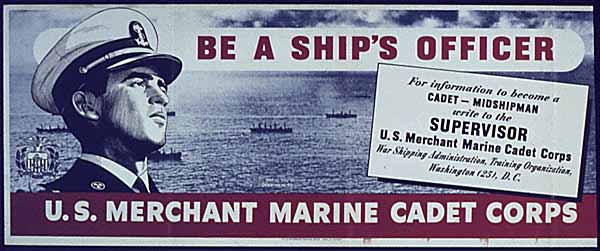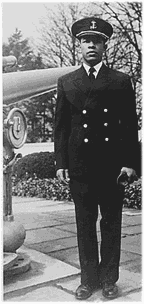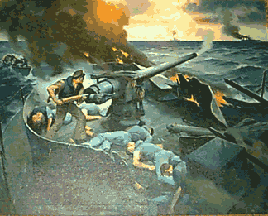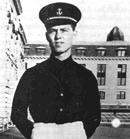History of the U.S. Merchant Marine Cadet Corps
Until 1874, young Americans who wanted careers at sea as officers had to work their way "up the hawsepipe," learning practical seamanship and navigation as best they could. That year, Congress authorized the Navy to lend ships to leading U.S. ports "for the instruction of youths in navigation, seamanship." New York Nautical School was the first to take advantage of the Act, and the only school which survived, eventually becoming State University of New York (SUNY).
In 1891 the Pennsylvania Nautical School started operation, followed two years later by the Massachusetts Nautical School, but both limited enrollment to state residents. Other state-funded Maritime schools for the training of officers, were established in California (1929), Maine (1941), and Texas.
In response to a need for officers to man the Emergency Fleet during WW I, the United States Shipping Board set up a crash training program in 1917. The 6 week long program, limited to men who had at least 2 years sea time, was called Free Training Schools for Merchant Marine Officers. There were 6,300 graduates as WW I ended, and 11,000 by the end of the program in 1921.
Another training program was based on the 1891 Postal Aid Law and 1928 Jones-White Act which mandated that ships accepting U.S. Government mail subsidies should take cadets for training --"one American-born boy under 21" for each 1,000 tons gross weight -- to be "educated in the duties of seamanship."
Unfortunately, the selection and training of "Mail Cadets" was haphazard at best: some cadets only wanted a free trip to Europe and had no intentions of a sea career; others complained of being given only the most menial chores and no training. Of 1,987 cadets placed with 13 shipping companies between 1932 and 1937, only 100 received licenses. [Two "Mail Cadets" were killed on the Morro Castle in 1934.]
Merchant Marine Act of 1936
The Merchant Marine Act of 1936, provided for establishment of Federal training for merchant marine officers. The U.S. Merchant Marine Cadet Corps was officially founded March 15, 1938 under the auspices of the U.S. Maritime Commission, chaired by Joseph P. Kennedy (father of President John F. Kennedy), a position taken over by Admiral Emory Scott Land.Initially, training of cadets was given aboard government-subsidized ships under the direction of shore-based Port Inspector-Instructors. In February 1942, administration of the training program was turned over to the Coast Guard, but in July 1942 it was given to the War Shipping Administration.
In 1941, the requirements for appointment as cadet were:
- American citizen between 18 and 25
- Good moral character, unmarried
- Between 5'4" and 6'4," in height
- Meet Navy physical requirements
- Meet requirements for sight, color perception, speech and hearing
- At least 15 high school credits
- Good teeth, good feet, good posture
[Note: Today entrance to the Academy is by Congressional Appointment and is open to men and women.]
After 8 weeks of "preliminary shore training" cadets went to sea by arrangement between a shipping company and the U.S. Maritime Service. Cadets were paid $50 per month, but had to pay for textbooks and uniforms. For the third year of training, cadets returned to shore to a Maritime Service Station or Training Ship, and worked at shipyards, stevedoring companies, etc. The fourth year, the cadet returned to sea at $70 per month.
The U.S. Maritime Service told the graduates "Graduation is as honorable and significant an achievement as graduation from West Point or Annapolis or the Coast Guard Academy." The young graduate sat for licensing examinations, and became an Ensign in the Naval Reserve, "subject to call by the Navy during emergencies or times of war."
The need for a permanent shore facility became obvious quickly. After several years of temporary facilities, Congress appropriated funds in 1942 for the purchase of the former Chrysler estate for an Academy at Kings Point, Long Island, New York. At the same time the Merchant Marine Cadet Schools were established at Pass Christian, Mississippi, and San Mateo, California.
The Merchant Marine Academy's campus was dedicated on September 30, 1943. A message from President Franklin D. Roosevelt read "the Academy serves the Merchant Marine as West Point serves the Army and Annapolis serves the Navy."
The Academy planned to offer a full 4 year undergraduate program which included sea training, but during wartime the course was condensed to 8 weeks of basic training, at least 6 months sea duty on a merchant ship, and 9 months of advanced training at the United States Merchant Marine Academy at Kings Point, NY.
In 1945, competitive examinations for appointment as Cadet-Midshipmen were held four times. Admission was based on scores on the examinations and State quotas based on population. Physical requirements were the same as for the Navy, and age requirement was 16 years 6 months to less than 23 years old.
The cadets at San Mateo were transferred to Kings Point in September 1947, and the school closed, becoming a junior college, and later, a nature preserve. Pass Christian Cadet School, already suffering severe financial problems, was devastated by a hurricane in September 1947. The School closed in 1950, the facilities turned into a religious college, then a resort.
More history and photos of Cadet Corps life in the 1940's at King's Point, San Mateo and Pass Christian
Enrollment in the Cadet CorpsThe first graduating class from the United States Merchant Marine Cadet Corps was in 1942.

 Joseph
Banks Williams, the first African-American to enroll at and
graduate from the U.S. Merchant Marine Cadet Corps, was a native
of Annapolis who was refused admission into the Naval Academy.
Williams was assigned deck cadet on the SS Booker T. Washington,
which carried war cargo to Europe and North Africa during his 10 months
aboard. After graduation he went on active duty with the Navy -- which
was finally accepting African-Americans as officers -- becoming the second
African-American to be made an officer in the Naval Civil Engineer Corps.
Joseph
Banks Williams, the first African-American to enroll at and
graduate from the U.S. Merchant Marine Cadet Corps, was a native
of Annapolis who was refused admission into the Naval Academy.
Williams was assigned deck cadet on the SS Booker T. Washington,
which carried war cargo to Europe and North Africa during his 10 months
aboard. After graduation he went on active duty with the Navy -- which
was finally accepting African-Americans as officers -- becoming the second
African-American to be made an officer in the Naval Civil Engineer Corps.
